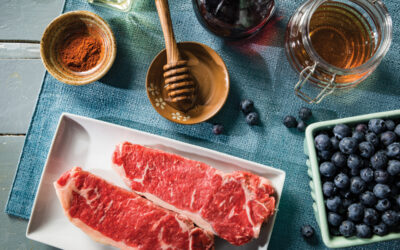

MARKET UPDATE
Last week’s cattle harvest was truncated on Monday with Veteran’s Day pulling Monday’s fed cattle harvest down to 88,000 head while the remaining weekdays averaged near 100,000 head each.
Cutout values continue to show weakness as weekly average prices have retreated nearly $8/cwt. for traditional Certified Angus Beef ® (CAB) brand carcasses. The downward price direction follows a particularly strong October trend that saw the CAB cutout increase by $20/cwt. from the first of the month.

Softer boxed beef prices coupled with Live Cattle futures trading at a slight discount to recent spot cash cattle values pushed cattle prices $2.21/cwt. lower last week. A stronger futures price trend developed early this week, taking the December contract to a premium compared to cash.
On the other hand, feeder cattle demand caught fire on the heels of widespread precipitation throughout much of the winter wheat grazing region, including Oklahoma and the Texas panhandle. Some markets reported calf prices jumping as much as $20/cwt. as grazers’ outlooks were much higher for winter growing conditions.
A review of carcass subprimal pricing shows the lower price trend across much of the chuck and round primal, including ground beef values. Ribs continue to show price stimulus with typical fourth quarter demand, trading at similar wholesale prices as this time last year. Strip loins and short loins are slightly higher than a year ago, but adjusting a bit lower in the last two weeks following a strong run-up in preceding weeks. Tenderloins remain near $2/lb. cheaper than a year ago but demand should take spot market prices higher into early December before dropping off.
Cow Harvest Unseasonally Low
Beef market watchers have discussed rebuilding the nation’s cow herd for months, anticipating a turnaround in cow numbers following healthy cow/calf margins and improving drought conditions. Gross cow/calf returns have exceeded expectations as the shrinking calf supply and strong beef demand collude to drive higher receipts. Even so, turnaround from the depth of the latest drought that brought beef cow harvest to a cyclical peak in 2022 has been slow to develop. The U.S. drought monitor has shown incremental improvement in November but widespread shades of abnormally dry to extremely dry conditions remain over a large portion of the U.S.
Record-high calf values are strong stimulus for cattlemen to maintain or increase cow herd inventories. Yet the value of heifer calves has been so good that many cow/calf producers have opted to merchandise a large percentage of the heifer crop rather than increasing retention rates for breeding. Aside from the obvious cash-in-hand, those willing to increase breeding female numbers may have encountered high interest rates, increasing cow costs and lack of labor as potential limiting factors. Recollection of the feeder cattle market crash following record-high replacement female prices in 2015 generates a modicum of caution for others.
Year to date, U.S. beef cow harvest has declined 19% (12,700 head per week) compared to 2023. Culling of spring-calving herds typically boosts beef cow harvest volume to the annual high in late October through November. So far that seasonal spike has not developed as beef cow harvest has remained flat since early September. This suggests that more mature cows are being retained in 2024 while the total supply is 1.8 million head smaller than two years ago.
Beef volume from the dairy side of the supply chain is also expected to remain in a downtrend. Latest data shows a dramatic dip in dairy cow harvest with a steep drop from 51,000 head per week in early September to just 32,000 head in late October. Despite rising production costs dairy profitability was record-large in September. The dairy segment has suffered lower production volume due to avian influenza while the profitable beef x dairy cross calves have pulled replacement heifer numbers lower in recent years. Even so, total year-over-year milk production is quoted as larger in 2025 by Mike North at Ever.Ag, who also states that both domestic and export demand for dairy products is sharp. Recent profitability in the dairy segment suggests that dairy herd expansion will limit additional short-term growth in beef x dairy calf supplies.
Read More CAB Insider
Cutout and Quality Strong
Summer weather has begun to set in with more regions of the country set to experience hotter temperatures. This means the traditional turning of consumer focus toward hamburgers and hot dogs rather than steaks, the spring favorite.
Onward with Quality
It’s been a quality-rich season in the fed cattle business with added days on feed and heavier weights continue to push quality grades higher.
It’s Beef Month
Wholesale and retail beef buyers have been preparing for weeks ahead of the spike in consumer beef buying associated with warmer weather and holiday grilling demand.





